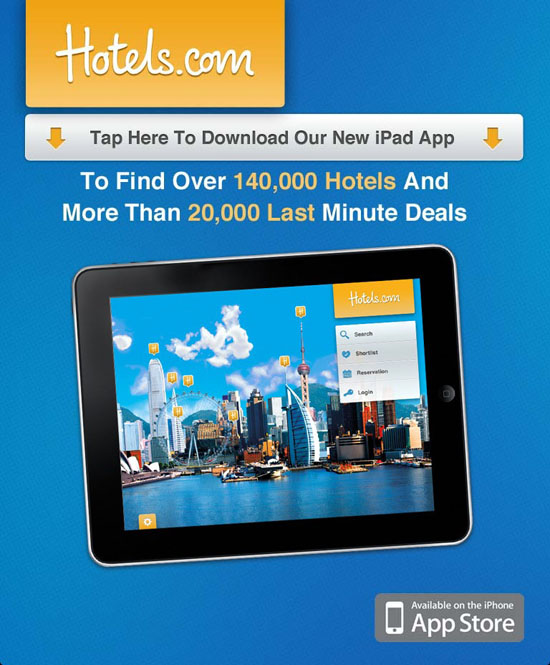In order to expand its global digital presence, Hotels.com created an app that was available on both the Android and iOS systems and accessible in 42 different countries. The goals for this campaign were to reach the top of the app charts, drive 10 percent of all global Hotels.com traffic through the mobile channel by the end of 2011, create an ongoing revenue stream via mobile, and produce effective and efficient ROI through integrated tracking.
Pre-launch, the app was promoted via banner ads, rich media ads, and mobile web interstitials. After the app launched, Hotels.com segmented its (undisclosed) target audience into three groups based on strategic importance. Tier one markets received a larger portion of the media budget (85 percent), while tier two received 15 percent of the budget and tier three was targeted for future launches. Tiers two and three were also used to test the app and any adjustments that needed to be made.
 To support the launch and increase traffic, highly targeted CPCP and CPM buys were made. Leveraging relationships with 13 key media partners, including Millennial, AdMob, and Mojiva, the brand was able to activate the campaign on a cost-per-download basis. Both local and global publishers were used to ensure greater media efficiency and gain access to localized content that was unavailable to global publishers.
To support the launch and increase traffic, highly targeted CPCP and CPM buys were made. Leveraging relationships with 13 key media partners, including Millennial, AdMob, and Mojiva, the brand was able to activate the campaign on a cost-per-download basis. Both local and global publishers were used to ensure greater media efficiency and gain access to localized content that was unavailable to global publishers.
To sustain the product's app store rankings, strategically targeted bursts of advertising were placed at key times on specific days. Doing this increased the visibility of the Hotels.com app and maximized brand exposure. To further improve media efficiency, already acquired users were frequency capped and blocked off where possible. Advertising spend was increased and targeted towards the highest performing systems and devices in individual markets while spend on the lowest performing systems and devices were excluded.
In order for Hotels.com to improve customer engagement in the long term, tracking mechanisms were set in place to collate data on app usage. This system, which connected mobile marketing with ROI, allowed Hotels.com to re-target inactive users, offer exclusive offers and deals, and re-engage regular users with bespoke content in the future. In-app conversions and referral URLs for all mobile marketing channels were tracked, including SMS, mobile search, link strategy, and affiliates.
The Hotels.com app reached No.1 in the travel category of the iTunes stores in 29 different countries and it reached the top 10 in the travel category of the iTunes stores in all 42 countries where the launch occurred.
Hotels.com was able to not only reach but surpass its initial goals of driving 10 percent of its global traffic through the mobile channel by the end of 2011. Metrics from December 2011 showed that global traffic was past the 17.5 percent mark. Mobile also accounted for 12.5 percent of Hotel.com's total global profit in 2011.